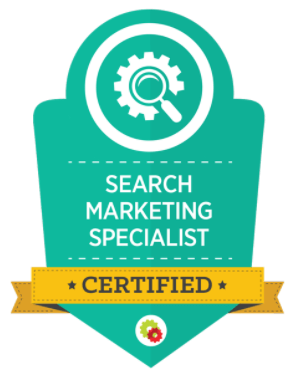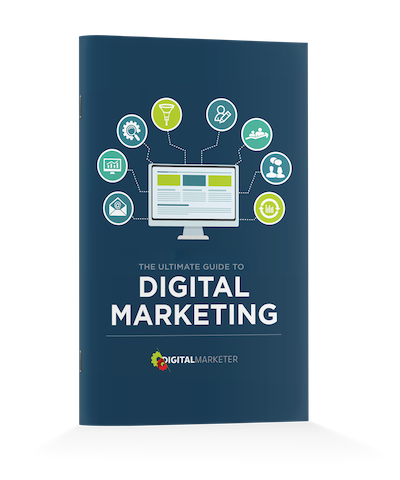CHAPTER
06
Designing Your Search Marketing Strategy
Algorithm updates. Semantic markup. Search intent.
One thing's for sure: search marketing ain’t what it used to be!
Luckily, all these changes are good news for digital marketers like us. Because we're not trying to game the system...
And when you're an honest marketer trying to deliver real value, you're building a solid foundation for search marketing success.
That being the case, search marketing can help you boost your website’s traffic and visitors’ trust while supporting your other digital marketing disciplines too.
In this chapter, you'll get an overview of the methods that are working now, including the lingo you'll use to talk about it, the metrics that will measure your success, and the business roles that should own your search marketing strategy.
Before we dig into the details, though, let’s cover a few foundational principles.
The Big Picture
First, SEO is a broad field divided into 2 big camps.
- The structural, or technical, side. People in this camp focus on the technical details of your website rather than the quality of your content.
- The content side of things. People in this camp know how to create well-optimized content, build links, and boost social shares.
Which camp is best?
There’s no contest. To succeed at search marketing, you need both. When you need to create link assets or get more backlinks, you need an SEO content specialist. But if Google doesn’t seem to see those assets, and you’re not ranking, you’ve likely got structural issues. You need an SEO technician.
Another thing to keep in mind is that SEO isn’t a once-and-done task.
Hundreds and thousands of websites are constantly battling for the #1 spot in search engines for their target keywords—and securing that spot is kind of like playing the kid’s game, "king of the mountain."

SEO is a bit like the kid's game, King of the Mountain.
You may knock off the guy who’s sitting there now, but someone is coming behind you, trying to knock you off as soon as you get there.
Which means your content needs to be finessed, updated, and promoted to rise in the search engine result pages (SERPs) and secure your top-ranking spot. Meanwhile, everything needs to be working right from a technical perspective.
Finally, search constantly changes. Google’s algorithm isn’t static. It’s based on artificial intelligence, and it’s learning more every day.
As a result, the rules change too. The tactics you use today won’t be the ones you use next month or next year. And that’s okay.
Expect to continue learning and adjusting the tactics you use. Don’t resist; just accept it as part of the process—because the only way to win at this game is by following the rules.
The Methods of Well-Executed Search
Search has evolved more than any other marketing discipline. Today, you must know the rules of search. Otherwise, you can hurt rather than help your brand.
So let’s start by reviewing the methods that are working well today.
Search Marketing Today
Today, Search Is Mobile
People are conducting searches from their mobile devices. That means your pages must be easily accessible from phones and tablets as well as computers.
It’s important to adopt a "mobile first" mindset.
Today, Search Is Structural and Technical
As mentioned above, if your site isn’t set up right, Google won't even see you. But once your structural issues are resolved, you’ll focus mostly on content and basic on-page optimization.
The key to SEO is simply to build a better page than anyone else on the web.
For each search query, Google wants to put the absolute best page at the top of the SERPs. So your page needs to be the most relevant and the closest match for searchers' intent.
How do you do that?
You research what's already ranking for your target keyword and build something 10x better than those pages.
That's it.
There's no hack and no easy button. Just a lot of hard work.
But on a positive note, if your content is 10x better than anything else on the web, your pages will rank.
Today, Search Is White Hat
Gone are the days of keyword stuffing. You must do what Google wants—and what they want is to provide a superior experience for their users.
Old-style gray-hat and black-hat SEO tactics were borderline illegal, and they’re definitely unethical. So that’s NOT the approach we’re going to take.
The tactics we cover will give you a sustainable business that’s reputable and trustworthy. And honestly, it’s the only way to grow your business long-term.
Today, Search Is Everywhere It Matters
What comes to mind when the topic of search marketing comes up?
Google, right?
They’re the premiere search engine, but be aware, they aren’t the only search engine in town.

Google is just one of many search engines you can optimize for.
Today, every channel that uses search has an algorithm that you can learn and leverage for success.
That means you aren’t limited to optimizing for Google. It may be more lucrative for your business to focus on Google Maps or iTunes.
Let me explain...
Google’s search bots are incredibly smart, which makes it hard to rise to the top of their SERPs. But most other search bots—think Amazon, Yelp, or Pinterest—are less complex and easier to understand. Not only that, there are likely fewer people competing for their top spots, so it’s an easier game to win.
We tend to equate search marketing with Google. But there’s a lot more to it than that. Search marketing is about producing the right content and publishing it on the right channels to attract the right customers, then doing what it takes to make your content rise to the top—whether that’s for Google or any other channel.
Approaching it this way, you’re taking the search game to a smaller playing field. While there may be fewer people searching those other channels, you’ll create content that’s optimized specifically for them.
Today, Search Is About More Than Traffic
When it comes to SEO, we talk about winning, ranking, and beating out the competition. You’d think that ranking at the top of Google (or whatever channel you’re using) is your top goal for search marketing.
But it’s not.
You can’t pay your bills with rank. And you can’t take traffic to the bank. In reality, those metrics are fluff. The real question is this: Are you making money from search?
The reason we do search marketing is to get more leads and sales, right? So in the next section, we’ll talk about a simple 6-part model for doing just that.
Wondering how your site is doing in search? Perform a DIY SEO Audit: High-Impact SEO in 5 Minutes or Less and find out.
The 6-Part Model for Winning at SEO
There are 3 stages of search marketing, each with 2 priorities. Let’s take a look at what they are, and then we'll look at the entire 6-part system in action.
Intent & Context

SEO starts with user intent.
What do we mean by that?
Essentially, everyone who types a query into Google’s search bar is looking for something. Regardless of the keywords they use, they have a specific intent.
But that intent exists within the context of what they’re doing and what they want or need. Both the intent and the context are critically important for you to understand.
For example, maybe they’re:
| Intent | Context (why they have this intent) |
|---|---|
| Hungry | They’re on the road and want to know the restaurants that are near them. |
| Lost | They need directions to the store they’re looking for. |
| Worried | Some weird symptoms have shown up and they want to know what could be causing them. |
| Stuck | They’re installing tile in their kitchen and need instructions on cutting tiles. |
| Making plans | They have an anniversary or other celebration coming up and are exploring their options. |
If you're targeting a keyword, you must understand the user intent and the context that’s behind the search.
Ask yourself: What is the prospect searching for? Why do they likely want this information?
For example, if they’re typing in "historic bed and breakfast," here’s what may be going on:

- Intent = find a B&B
- Context = anniversary is coming up
The context is vital information, and you need to ferret it out, because it will help you know what information to provide in your content.
Fortunately, the best research tool on the planet is easily accessible. It’s your own brain. Think about your customers. What searches are they performing when looking for or using your product? Why are they searching for that information?
Identify the keywords they’re likely using, then try to understand the intent and context around those searches. The idea is to anticipate their needs.
To help, do a quick Google search. Begin typing the keyword into Google and look at the autosuggestions Google provides (see the image above for an example). These suggestions are the most common searches related to the words you’re typing in, and from them, you can guess what people are looking for.
Asset & Channel

Once you know the information people are looking for and why they likely want that information, you need to build a unique asset for each of those needs.
This stage of the process is all about content creation. Before you start, ask yourself these questions:
- What keyword/intent am I targeting?
- What asset will satisfy that search?
- Where should the asset live?
Learn the types of content you can create for different intents at different stages of the funnel. Read Perfect Content Marketing: How Content Generates Leads and Sales at Every Step of the Funnel.
Let’s say the query is, "start a vegetable garden." The asset could be a blog post. Since people search for blog posts in Google, that’s the channel you’ll optimize for.

- Asset = blog post
- Channel = Google search
But Google isn’t the only option. What if they’re looking for images to inspire them?

- Asset = Pinterest pin
- Channel = Pinterest
Or maybe they want to create the best garden in their community and want in-depth information:

- Asset = Book
- Channel = Amazon Kindle
This same approach works for brick-and-mortar businesses. Let’s go back to the B&B example we used earlier. What if people are looking for a B&B in St. Louis for their anniversary?

- Asset = the B&B’s business listing
- Channel = Google maps
Maybe they’re looking for reviews and suggestions:

- Asset = trip advisor listing
- Channel = Trip Advisor
Or maybe they want to see it in HD video.

- Asset = video
- Channel = YouTube
Your goal is to choose an asset that will best answer the intent/context you’ve identified, then choose the channel the asset will live on.
Once you’ve done that, you’re ready for the last stage of the optimization process.
Optimization & Ascension

At this point, you've created the assets to address specific search queries, and you're ready to upload them to their appropriate channels.
Now it’s time to optimize it for each channel’s search algorithm and develop your customer ascension plan. For this, you’ll need to answer these questions:
- How will the prospect find this asset?
- What is the next step in the customer journey?
Traffic isn't your end goal, remember. Your ultimate goal is to create leads and sales. So you always need to tell visitors what their next step is, and those directions need to be built into the asset.
Let's look at some examples.
We'll start with our vegetable garden search. Notice in this image that the asset is a blog post and its title tag is optimized for Google.

The asset is a blog post, and the title is optimized for Google.
Want to learn more on-page optimization for blog posts? Read How to Do On-Page SEO in WordPress.
If we click through to that blog post, we can clearly see the ascension path.

Visitors can easily identify their next step.
Notice the button embedded within the content and the product offers in the sidebar. Clearly, this site has developed an ascension path that looks something like this:
Google search > blog post > shop > purchase
They aren’t merely optimizing for search traffic. They’re optimizing for sales.
That’s what you want to do as well: pull traffic in and convert it. And here’s how you can get started now.
- Go onto Google Analytics and find the pages on your site that get the most traffic.
- Think about the logical next step for the traffic on those pages.
- Put a call to action (CTA) somewhere on the page leading visitors to that next step.
This is what search marketing is all about. It’s organic, so it’s free money. And all you need to do is put an ascension path on your high-traffic pages.
It’s the same on YouTube. In this example, the video title is optimized for the keyword, "save money on groceries."

Keyword being optimized for: save money on groceries
You can see the ascension path is both in the video and under it. Within the video are links to a fat-burning workout product. Below the video is a link to her new book.

Ascension path tells viewers what to do next.
Most SEO training focuses solely on traffic. The goal is primarily to rank at the top of Google.
But as you can see, people are searching for information in multiple channels, so there’s no reason to limit yourself. If ranking on Page 1 for Google isn’t possible, ranking #1 in Pinterest or YouTube might be a better option.
And traffic isn’t the end goal. Conversions are. So think beyond traffic. Clearly promote your ascension path within your assets, spelling out what they should do after consuming your content.
Now let’s look at the entire process, from start to finish.
The 6-Part System in Action
Let’s assume I’m Home Depot and want to create some YouTube videos targeting the keyword, "tile my bathroom." I start by identifying the intent and context around that search query.
- Keyword = "tile my bathroom"
- Intent = to tile my bathroom
- Context = My wife hates the old tile in our bathroom.

- Asset = video on how to tile your floor

- Channel = YouTube

- Optimization = Use the intent-based keyword in the title and description (basic YouTube SEO).

- Ascension = Leverage YouTube’s built-in ascension paths.

As you can see, this isn’t hard. In fact, it gives you a logical workflow that will help you create better content that meets the real needs of your best customers.
You simply need to figure out what you want to rank for, look at the top-ranking content, and create something better. Then optimize and create your ascension path.
Now let’s look at the lingo used by search marketers.
The Lingo: How does a Search Marketer Talk?
What are the terms you need to know as an SEO? These 4 terms will give you a solid foundation for talking about search marketing.
Technical SEO
Technical SEO is about optimizing the structure and code of a website so search engines can find, understand, and send traffic to that site.
This is a smart focus if you’re technically minded. Technical SEOs are skilled at tweaking code, setting up servers, and finding the technical issues that keep a search-engine spider from understanding what your site’s about.
When are technical SEOs called in?
Most websites use a good content management system like Wordpress or Shopify. Both are built with solid technical SEO in place, so right out of the box, their technical SEO will be good.
But as a site gets bigger, especially if more than one person can make changes to the site, it’s almost guaranteed it will develop technical SEO problems at some point.
Site hacks are another issue that technical SEOs can help with. Google won’t send you traffic if your site gets hacked, and they’ll put you in the penalty box until the issue gets resolved.
That’s just two scenarios, but there are countless technical issues that can keep your site from performing well in search engines. That's why technical SEO is so important. When you remove the tech problem, your search position can get an immediate boost.
Intent
A person’s goal when typing a search query on the web. What information are they looking for? What are they hoping to achieve with that information?
A person’s goal when typing a search query on the web. What information are they looking for? What are they hoping to achieve with that information?
Asset
The content produced to satisfy the intent of a customer or prospect. It may include blog posts, product pages, social media profiles, podcasts, videos, and more.
Once you know the intent of a customer’s search, you need to design an asset to satisfy that intent.
Channel
The digital "home" of an asset designed to meet the intent of a customer or prospect. Assets might live on a website or blog, but they may also live on large content hubs like Amazon, Pinterest, iTunes, and TripAdvisor.
Metrics
What are the metrics that will help you track and improve your search marketing? Here are 4 to start with.
Traffic by Channel report
In Google Analytics, this is the first report we typically look at when we get access to a site. It tells you a lot at a high level: Where are we hurting? Are your traffic sources relatively balanced or does traffic come from just one or two channels?

When sites don’t do search marketing, their traffic tends to come from Direct or Email. Once search marketing has been implemented, though, you’ll begin to see more balance.
Quantity/Quality of Backlinks
Here at DigitalMarketer, we use Moz Open Site Explorer for this metric. But you can use other free tools, such as MonitorBacklinks, or paid tools, such as Ahrefs.

You want to track how many websites are linking to your site.
You want to run this report monthly or quarterly to track how many websites are linking to your site. That number should be trending upward, with more and more quality sites linking to you.
Keyword Rankings
Once you’ve identified the keywords you want to rank for, you need to track your position for those keywords.
For this, you can use the SERPs Keyword Rank Checker. Just type in your keyword and see where you rank.

Track where you rank in the SERPs for important keywords.
In this example, we typed in "email subject lines," and as you can see, we rank #4 for that term.
You can also see who’s outranking you. To make your page rank better, review their content and update yours to be 10x better.
Conversions from Search
If you’ve set up Ecommerce or Goals in Google Analytics, you can go to the Channels report and look at the top-line revenue and number of transactions over time.

Google's channels report is important if you've set ecommerce goals.
The metrics to focus on are Sessions, Revenue, and Transactions. Here, we have $67,000 from 2,000 transactions. To calculate the conversion rate, divide revenue by transactions.
$67,285.55 / 2130 = $31.59 per transaction
The Roles: Who Has Responsibility for Search Marketing?
To succeed at search marketing, you need 3 teams to have input and responsibility.

The Content Team
Search and content go hand in hand. Understanding SEO will help your content team bring in more organic traffic from multiple channels.
IT and Tech Teams
Technical SEO is your tech team’s domain. If they don’t have training in technical SEO, they’re probably throwing up some speed bumps that keep you from ranking well in search.
Public Relations
As with the content team, your PR team need to understand search marketing to achieve their goals.
Summing Up
Search marketing doesn’t happen in a bubble. Ideally it will integrate with every aspect of your marketing, from customer research to content creation to customer value optimization.
We’ve provided a good overview of how you can do this—but it’s a lot to take in at once. The good news is you'll get better over time. Just start where you are, and over time, you'll see improvements in your page rank and traffic.
The next chapter will help as well—because SEO and analytics go hand in hand. And you'll appreciate our down-to-earth approach to analytics. (It takes the fear—and a lot of the pain—of numbers out of the equation.)
Become a Search Marketing Specialist
With all the "noise" in today’s world, it’s critical that brands and business get found when a customer or prospect is looking for them.
It’s also critical that your brand is shown in a positive light when the right person is looking for a solution that YOU provide.
And that’s exactly what you’ll learn how to do in this mastery course:
- How to leverage search channels such as Google, Amazon and even local channels such as Yelp.
- How to ensure that your brand gets found.
- And when it’s found, how to ensure the message your prospects see is a positive one.











